Google's Tensor inside of Pixel 6, Pixel 6 Pro: A Look into Performance & Efficiency
by Andrei Frumusanu on November 2, 2021 8:00 AM EST- Posted in
- Mobile
- Smartphones
- SoCs
- Pixel 6
- Pixel 6 Pro
- Google Tensor
Google's IP: Tensor TPU/NPU
At the heart of the Google Tensor, we find the TPU which actually gives the chip is marketing name. Developed by Google with input and feedback by the team’s research teams, taking advantage of years of extensive experience in the field of machine learning, Google puts a lot of value into the experiences that the new TPU allows for Pixel 6 phones. There’s a lot to talk about here, but let’s first try to break down some numbers, to try to see where the performance of the Tensor ends up relative to the competition.
We start off with MLCommon’s MLPerf – the benchmark suite works closely with all industry vendors in designing something that is representative of actual workloads that run on devices. We also run variants of the benchmark which are able to take advantage of various vendors SDKs and acceleration frameworks. Google had sent us a variant of the MLPerf app to test the Pixel 6 phones with – it’s to be noted that the workloads on the Tensor run via NNAPI, while other phones are optimised to run through the respective chip vendor’s libraries, such as Qualcomm’s SNPE, Samsung’s EDEN, or MediaTek’s Neuron – unfortunately only the Apple variant is lacking CoreML acceleration, thus we should expect lower scores on the A15.

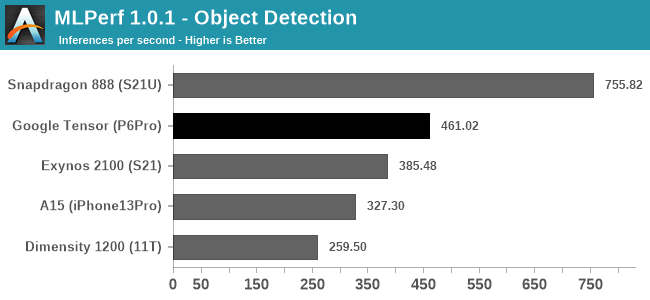
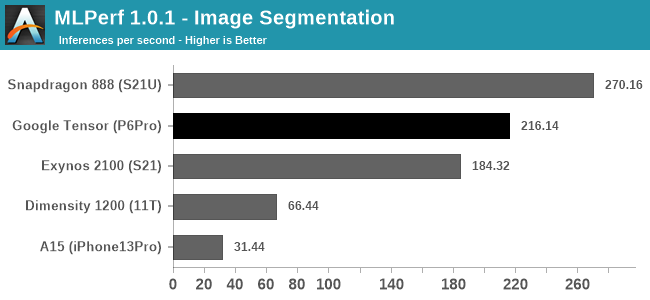
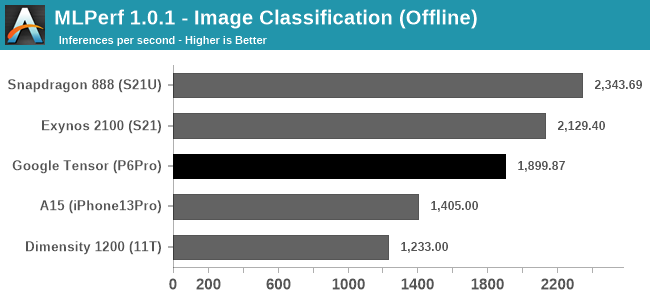
Starting off with the Image Classification, Object Detection, and Image Segmentation workloads, the Pixel 6 Pro and the Google Tensor showcase good performance, and the phone is able to outperform the Exynos 2100’s NPU and software stack. More recently, Qualcomm had optimised its software implementation for MLPerf 1.1, able to achieve higher scores than a few months ago, and this allows the Snapdragon 888 to achieve significantly better scores than what we’re seeing on the Google Tensor and the TPU – at least for those workloads, in the current software releases and optimisations.
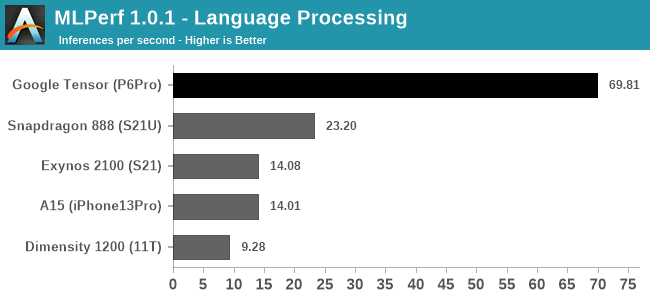
The Language Processing test of MLPerf is a MobileBERT model, and here for either architectural reasons of the TPU, or just a vastly superior software implementation, the Google Tensor is able to obliterate the competition in terms of inference speed.
In Google’s marketing, language processing, such as live transcribing, and live translations, are very major parts of the differentiating features that the new Google Tensor enables for the Pixel 6 series devices – in fact, when talking about the TPU performance, it’s exactly these workloads that the company highlights as being the killer use-cases and what the company calls state-of-the-art.
If the scores here are indeed a direct representation of Google’s design focus of the TPU, then that’s a massively impressive competitive advantage over other platforms, as it represents a giant leap in performance.
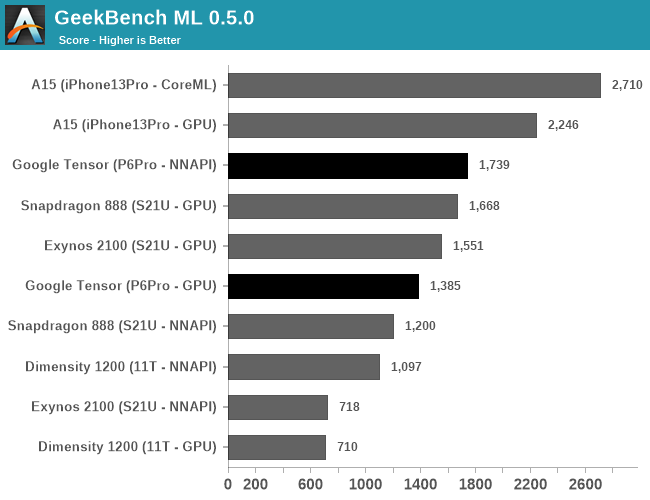
Other benchmarks we have available are for example GeekBench ML, which is currently still in a pre-release state in that the models and acceleration can still change in further updates.
The performance here depends on the APIs used, with the test either allowing TensorFlow delegates for the GPU or CPU, or using NNAPI on Android devices (and CoreML on iOS). The GPU results should only represent the GPU ML performance, which is surprisingly not that great on the Tensor, as it somehow lands below the Exynos 2100’s GPU.
In NNAPI mode, the Tensor is able to more clearly distinguish itself from the other SoCs, showcasing a 44% lead over the Snapdragon 888. It’s likely this represent the TPU performance lead, however it’s very hard to come to conclusions when it comes to such abstractions layer APIs.
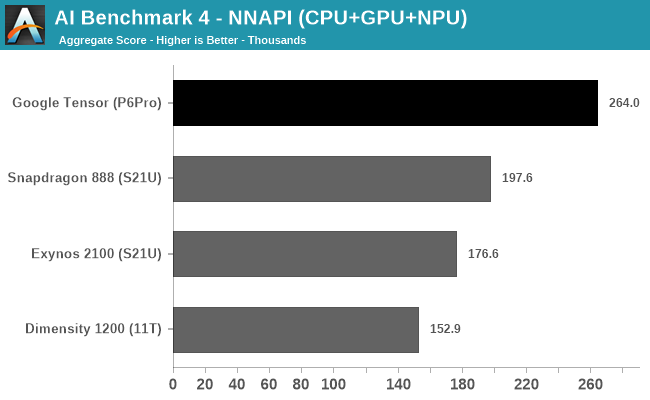
In AI Benchmark 4, when running the benchmark in pure NNAPI mode, the Google Tensor again showcases a very large performance advantage over the competition. Again, it’s hard to come to conclusions as to what’s driving the performance here as there’s use of CPU, GPU, and NPUs.
I briefly looked at the power profile of the Pixel 6 Pro when running the test, and it showcased similar power figures to the Exynos 2100, which extremely high burst power figures of up to 14W when doing individual inferences. Due to the much higher performance the Tensor showcases, it also means it’s that much more efficient. The Snapdragon 888 peaked around 12W in the same workloads, so the efficiency gap here isn’t as large, however it’s still in favour of Google’s chip.
All in all, Google’s ML performance of the Tensor has been its main marketing point, and Google doesn’t disappoint in that regard, as the chip and the TPU seemingly are able to showcase extremely large performance advantages over the competition. While power is still very high, completing an inference faster means that energy efficiency is also much better.
I asked Google what their plans are in regards to the software side of things for the TPU – whether they’ll be releasing a public SDK for developers to tap into the TPU, or whether things will remain more NNAPI centric like how they are today on the Pixels. The company wouldn’t commit yet to any plans as it’s still very early – in generally that’s the same tone we’ve heard from other companies as even Samsung, even 2 years after the release of their first-gen NPU, doesn’t publicly make available their Eden SDK. Google notes that there is massive performance potential for the TPU and that the Pixel 6 phones are able to use them in first-party software, which enables the many ML features for the camera, and many translation features on the phone.










108 Comments
View All Comments
TheinsanegamerN - Tuesday, November 2, 2021 - link
Not cheap, just poorly designed. Too much focus on magic and not enough on the fundamentals of a good chip design.Alistair - Wednesday, November 3, 2021 - link
cheaply made, i mean, with a CPU with A76 cores... lol...tuxRoller - Tuesday, November 2, 2021 - link
All companies other than those that Apple need should just admit defeat and give themselves over.Just needed to be said.
TheinsanegamerN - Tuesday, November 2, 2021 - link
The rest of the world is not america. Without america apple is a tiny minority of devices.Alistair - Wednesday, November 3, 2021 - link
? seriously? Apple is dominant in Japan, Taiwan, and a gazillion other countriesicedeocampo - Wednesday, November 3, 2021 - link
last time I checked there were just 195 countriesAlistair - Wednesday, November 3, 2021 - link
you know hyperbole right? your response is not an argument...ss91 - Thursday, November 4, 2021 - link
You both are wrong. Yes, it’s true apple is not the majority device supplier. Yes, it’s also true that apple is far far ahead.But what is wrong is that
1. @TheinsanegamerN : Where apple doesn’t dominate, they are predominantly lower segment markets where avg smartphone price is far below the cheapest iPhone.
Apple sells more iPhones than Samsung sells Notes (RIP), S series and fold/flip. Samsung sells overall more phones because they operate in price segments all the way from $200 to $2000 while apple starts $400.
You can be sure that SE Asia, S.America and Africa uses androids, but it’s also true that these androids are far from the bleeding edge flagships.
2. @tuxRoller : Competition is important. If Samsung won’t team up with AMD, Adreno and Mail will become complicit. If Tensor doesn’t outperform ML tasks, exynos and Qualcomm won’t innovate there. If apple won’t have started the 64bit and Custom CPU race, nothing would be same today.
tuxRoller - Friday, November 5, 2021 - link
Sorry for the bit of trolling, but, to be clear, that was trolling. I wasn't being serious.aclos3 - Wednesday, November 3, 2021 - link
I am really happy with my Pixel 6 pro so far. Above all, I want my phone to have a really excellent camera and every new mid to high end phone now is plenty fast for just about any use. I bet the Pixel 6 takes much better pictures than whatever "trash" you are using. But you sure have them beat when it comes to the benchmarks I bet.